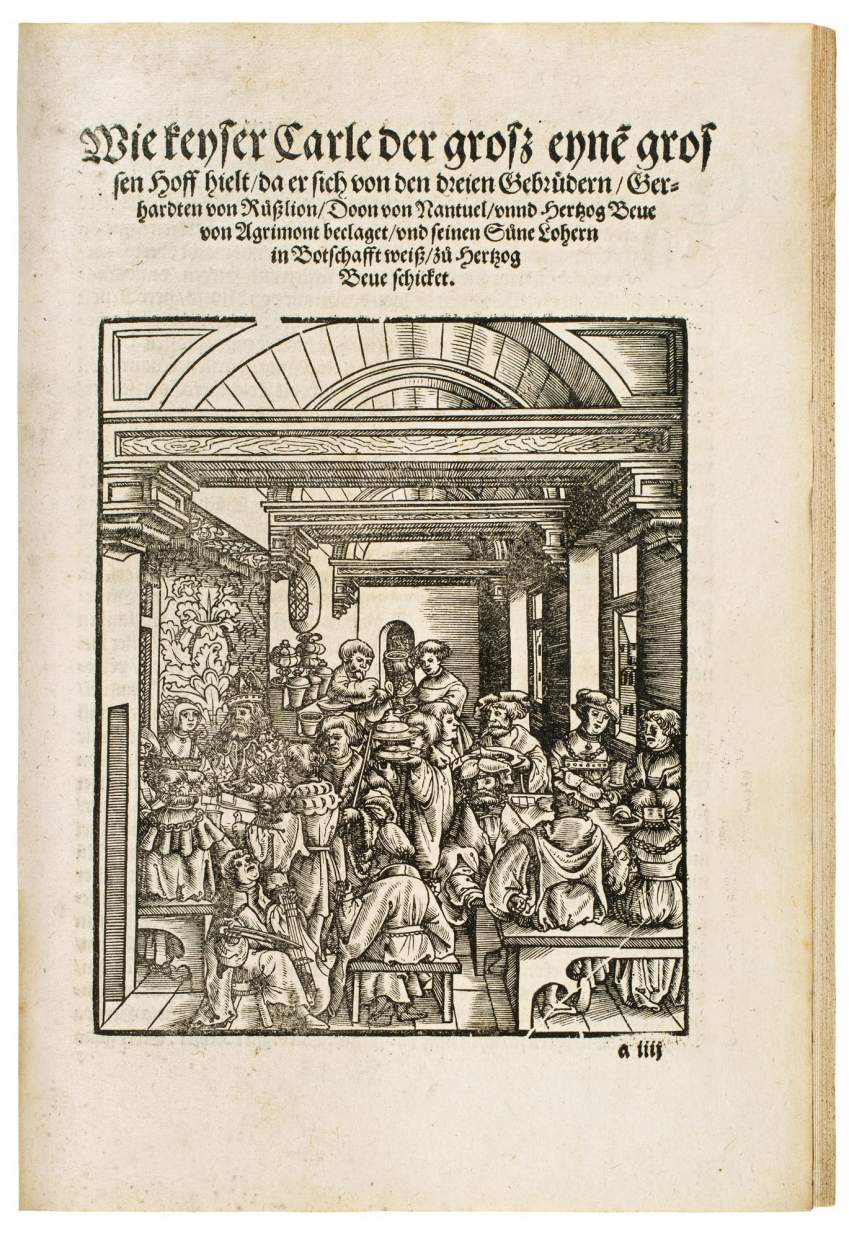Artworks


(Les quatre fils Aymon, in German) EYn schön lustig Geschicht, wie Keyser Carle ... Simmern: Hieronymus Rodler, 25 February 1535. First edition in High German.
307 x 204 mm. 167 leaves. 62 woodcuts, printed from 27 blocks. The translator of this prose novel has been identified with Johann II, Count Palatine and Duke of Simmern.


(Les quatre fils Aymon, in German) EYn schön lustig Geschicht, wie Keyser Carle ... Simmern: Hieronymus Rodler, 25 February 1535. First edition in High German.
307 x 204 mm. 167 leaves. 62 woodcuts, printed from 27 blocks. The translator of this prose novel has been identified with Johann II, Count Palatine and Duke of Simmern.
Hide caption

(Les quatre fils Aymon, in German) EYn schön lustig Geschicht, wie Keyser Carle ... Simmern: Hieronymus Rodler, 25 February 1535. First edition in High German.
307 x 204 mm. 167 leaves. 62 woodcuts, printed from 27 blocks. The translator of this prose novel has been identified with Johann II, Count Palatine and Duke of Simmern.
Hide caption
62 elaborate woodcuts decorate this very rare first edition of the High German version of the Haimonskinder. Originally in old French, the epic saga tells the story of four sons of Duke Haimon of Dordogne and their legendary battles against emperor Charlemagne. The text was first created for 12th-century French courtly and chivalrous circles, and its epic themes made its translations, into other vernacular languages immensely popular long into the 19th century. The translator of this text has been identified as Johann II, Count Palatine and Duke of Simmern (1492-1557), a renowned patron of the arts.
The heart of the story deals with the conflict between Duke Haimon and the Emperor Charlemagne. The animosity starts when Haimon and his cousins are denied their rightful reward for their war service. After a rancorous combat that continues for many years and costs endless lives, Charlemagne offers peace by granting Haimon the hand of his sister Aia. After another slight by Charlemagne on the wedding day, Haimon vows that he will eliminate all of Charlemagne’s descendants – his own offspring included. Thus, his wife conceals the birth of her four sons and only reveals their existence after she learns how much her husband yearns for children of his own. The youngest, Reynhardt, (or Reinhold) has his father’s irascible temper and audacity. He tames a magic horse called Bayard that becomes his invincible companion. He and his three brothers continue their father’s hostility towards Charlemagne. After a long and eventful series of battles the monarch wins the conflict and gives orders to slay the mystical horse. Thereupon, Reynhardt leaves his country for a pilgrimage and ends up in Cologne where he works as a simple builder at the cathedral, endures a cruel death, and is eventually canonised. His relics were transferred to Dortmund, where he is the patron saint of both town and cathedral.
The large and incredibly detailed woodcut on the title page shows emperor Charlemagne meeting the four sons of Duke Haimon of Dordogne, at the famous banquet where Haimon was again slighted by Charlemagne. The emperor is seated on the left of the composition, identified by his splendid jerkin and crown, reminiscent of Albrecht Dürer’s 1512 portrait. The splendid interior of the feast hall with its wooden beams is filled with guests wearing traditional Renaissance clothing with wide sleeves and elegant slitted hats. The narrow shading and hatching lends a velvet quality to the garments.
All in all, fifty-eight large woodcuts illustrate the text, spanning the width of the page. Some were already in use in other books printed in by Rodler: Rüxner’s celebrated Book of Tournament and the fascinating tale of Fierrabras. The twelve new blocks created especially for the edition at hand show the influence of the prolific Conrad Faber von Creuznach. He was known as illustrator of Roman classics at Schoeffer’s influential workshop near Mainz. Two of the Rüxner woodcuts bear the initials HH, meaning Herzog Hans (or Hans vom Hunsrück), the popular name of Duke Johann II. The designs of our woodcuts may thus be attributed to the duke himself.



